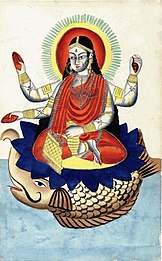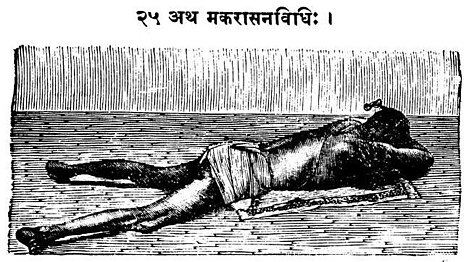Makarasana

Makarasana (
Etymology and origins
The name comes from the Sanskrit मकर makara meaning "crocodile" or "monster",[2] and आसन āsana meaning "posture" or "seat".[3]
Makarasana is described in the 17th-century Gheraṇḍa Saṁhitā (Chapter 2, Verse 40). It is described and illustrated in halftone in the 1905 Yogasopana Purvacatuska.[4]
-
Ganga
-
Makarasana in Yogasopana, 1905
Description
In Light on Yoga, B. K. S. Iyengar notes that the Gheranda Samhita describes the pose as lying prone with both legs "stretched out"; the head is caught in the arms, and the pose is said to "increase bodily heat". Iyengar describes it as a variation of Salabhasana, locust pose and illustrates it as such, with the head and legs raised energetically, the fingers interlocked clasping the back of the head, and the elbows high off the ground.[7]
Makarasana is however often used as a relaxation asana, an alternative to the supine Shavasana, and both head and legs are rested on the floor. Yoga International describes it as having the chest "slightly raised", and as "one of the best postures for working with diaphragmatic breathing".[5]
See also
- Bhujangasana, Cobra pose
References
- ^ "Makarasana". Yoga Point. Retrieved 2011-04-09.
- ISBN 978-81-248-0183-3.
- ISBN 978-81-7041-293-9.
- ^ Ghamande, Narayana (1905). Yogasopana Purvacatuska (1st ed.). Bombay: Janardan Mahadev Gurjar, Niranayasagar Press. p. 75.
- ^ a b Anderson, Sandra. "Makarasana: The Crocodile Pose". Yoga International. Retrieved 18 December 2018.
- ^ a b Newell, Zo. "The Mythology Behind Makarasana (Crocodile Pose)". Yoga International. Retrieved 18 December 2018.
- ^ Iyengar 1979, pp. 100–101.
Sources
- Iyengar, B. K. S. (1979) [1966]. Light on Yoga: Yoga Dipika. Unwin Paperbacks.





